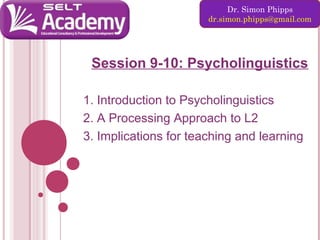
CTS-Academic: Module 2 session 8 psycholinguistics
- 1. Dr. Simon Phipps dr.simon.phipps@gmail.com Session 9-10: Psycholinguistics 1. Introduction to Psycholinguistics 2. A Processing Approach to L2 3. Implications for teaching and learning
- 2. WHAT IS PSYCHOLINGUISTICS 1 (the study of language use in order to understand the nature and structure of the human mind) oldest science newest science = = astronomy psychology ‘the mind itself…is the least amenable to objective study’ (Scovel 1998:3) 4 subfields of psycholinguistics How language is acquired produced comprehended lost 1. Development of language (in L1) (common stages, different rates of language development) Crying Gurgling/Cooing 2 months Babbling 6 months Babbling in L1 8 months su Words 1 year (Holophrastic words) Baba 2 words 2 years gel 14,000 words 6 years
- 3. WHAT IS PSYCHOLINGUISTICS 2 2. Production of Language 4 stages; Conceptualisation Formulation Articulation Self-monitoring Speech production is a parallel two-way system output monitoring and editing Communication is an interactive process with others with self Communication is a highly complex process we often only see this when it breaks down ‘slips of the tongue’
- 4. WHAT IS PSYCHOLINGUISTICS 3 3. Comprehension of Language of sounds individual sounds and whole phoneme restoration voice onset timing of words parallel distributed processing spreading activation networks schemata of sentences predict next word garden-pathing of texts top down processing 4. Loss of Language (Aphasia) Broca’s area - production Wernicke’s area - comprehension 2 hemispheres – neuroplasticity, localisation of functions
- 6. GARDEN PATH SENTENCES The baby pop star wants to adopt arrives in London. The complex houses married and single students and their families. The cotton clothing is usually made of grows in Mississippi. Fat people eat accumulates. I convinced her children are noisy.
- 7. Scrambled words “AOCCDRNİG TO RSEEARCH AT AN ELİNGSH UİNERVTİSY, İT DEOSN’T MTTAER İN WAHT OREDR THE LTTEERS İN A WROD ARE, THE OLNY İPRMOATNT TİHNG İS TAHT THE FRİST AND LSAT LTTEER İS IN THE RGHİT PCLAE. THE RSET CAN BE A TOATL MSES AND YOU CAN SİTLL RAED İT WOUTHİT A PORBELM. TİHS İS BCUSEAE WE DO NOT RAED ERVEY LTETER BY İSTLEF BUT THE WROD AS A WLOHE.”
- 8. IMPLICATIONS FOR TEACHING Personalisation Prediction Pronunciation Collocation Production Comprehension Rehearsal, practice Tolerance
- 9. PSYCHOLINGUISTIC PROCESSES OF LEARNING Human beings are limited in their capacity to consciously attend to more than one task at a time Memory speed Limited processing capacity, but Memory is unlimited Processing capacity is limited we cannot attend to all language some language is automatic vast memory capacity
- 10. PSYCHOLINGUISTIC PROCESSES OF LEARNING Dual-coding system Rule based system R E Rules Exemplar-based system Examples of language • individual words • chunks of language Most language we use is not new Working memory vs LTM The more we use language, the more automatic it becomes The more automatic it becomes, the less we need rules L2 learners typically use the rule system more; because they don’t have enough exemplars stored so, they are less fluent from Skehan, P. (1998). A Cognitive Approach to Language Learning. Cambridge: OUP.
